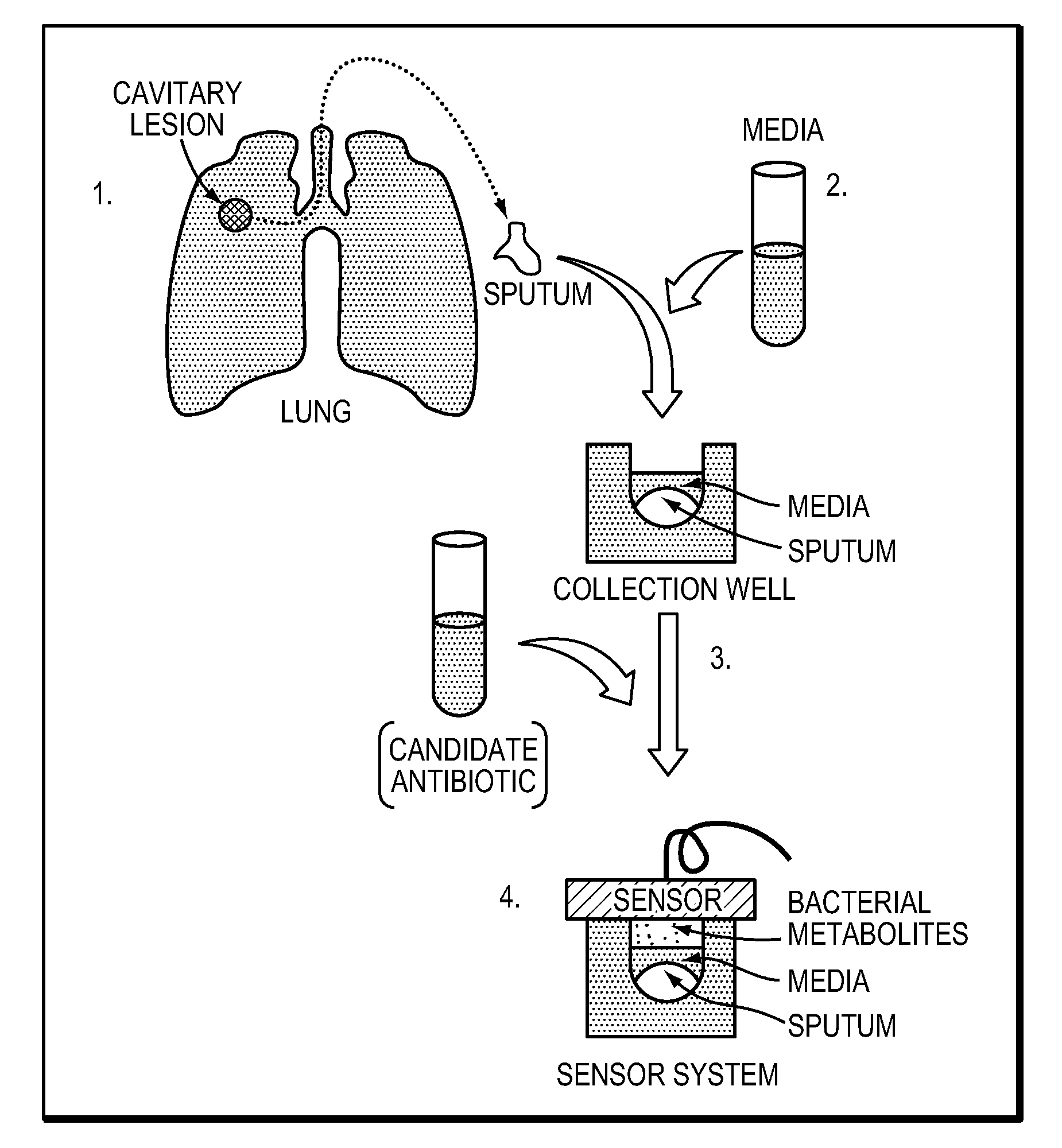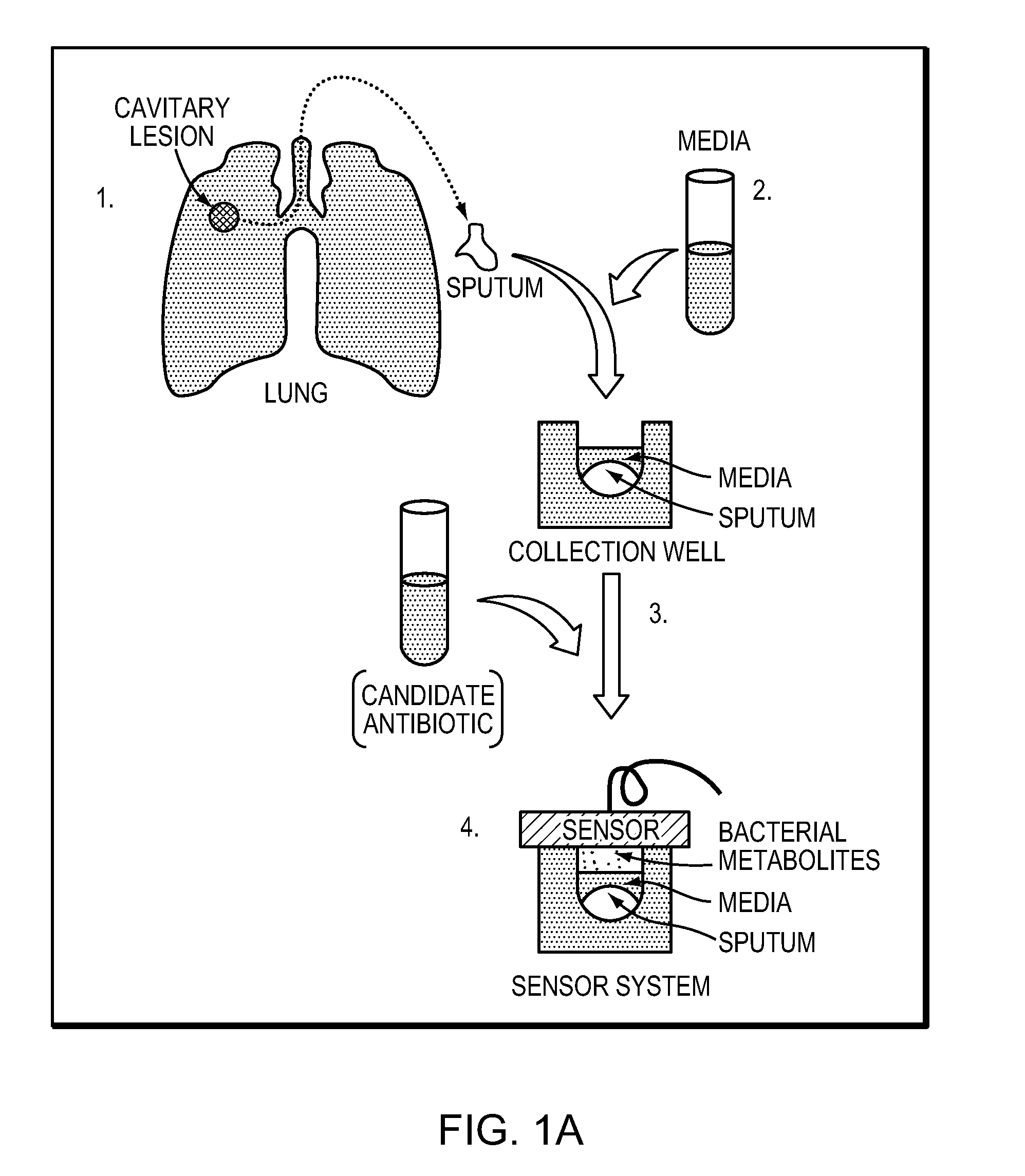Rapid detection of volatile organic compounds for identification of bacteria in a sample
a technology of volatile organic compounds and bacteria, which is applied in the field of rapid detection of volatile organic compounds for the identification of bacteria in a sample, can solve the problems of increasing global health problems, bacterial contamination, and the spread of drug-resistant bacteria, and achieve the effect of changing the burden and/or efficacy of bacteria
- Summary
- Abstract
- Description
- Claims
- Application Information
AI Technical Summary
Benefits of technology
Problems solved by technology
Method used
Image
Examples
example 1
[0086]To evaluate the ability of the method to detect bacterial VOCs, two studies with MTb as well as two additional mycobacteria, M. smegmatis (MSmeg) and M. avium (MAC) as control strains, were conducted. In the first study, two strains of MTb and one strain of MAC were cultured at low concentrations (˜10̂5 bacilli / mL) in Bactec™ 12B media. This investigation confirmed that bacterial identification was possible at these low bacilli concentrations and confirmed that the method is capable of identifying: a) each bacterium from its matched medium; b) one MTb strain from another MTb strain; and c) MTb from a mycobacterium control strain (MAC). In the second study, the quantity of VOCs extracted from the headspace was increased to confirm that the compounds could be identified by mass spectrometry.
1a. Culture and Data Acquisition Methods
[0087]FIG. 1B as described above illustrates the general method that was used to acquire the data for the two studies. Bacteria were grown in Bactec™ b...
example 2
[0098]Data from three sets of samples were collected and analyzed. The three sets of samples included M. tuberculosis in Middlebrook 7H9 with added propionate (referred to as lipid phase), M. tuberculosis in Middlebrook 7H9, and M. smegmatis in the lipid phase. Media alone and air extraction served as controls for each data set. The volatiles from the headspace for each bacteria sample was extracted using SPME fibers during the exponential growth phase by exposure of the fiber to the headgas for 30 minutes, and the OD values were 0.48, 0.48, and 0.63, respectively, for MTb in lipid, MTb in 7H9, and M. smegmatis. The volatiles from the headspace for the non-bacteria samples was extracted in the same manner as the bacteria above and it should be noted the media was incubated for the same period of time in the same vessels and conditions. The relevant samples are summarized in Table B.
TABLE BMass Spectrometry analysis of samples analyzedfor the MTb Lipid StudyConditionsSample Identific...
example 3
[0152]This example describes a method for identifying particular bacteria (e.g., S. aureus, K. pneumonia, and E. coli) in a sample using data from both GC-MS analysis and DMS analysis. Accordingly, this example also describes a library of data and a method for generating a library of data for a point-of-care diagnostic tool to facilitate rapid identification of the bacteria in a sample. A micromachined DMS device is an example of a point-of-care diagnostic tool. The DMS device is portable and the detection methodology is capable of low limits of detection of analytes.
[0153]Specifically, simultaneous analysis by GC-MS and DMS was used to identify medically important bacteria in a sample, including Staphylococcus aureus, Klebsiella pneumonia and Escherichia coli. A dual system platform allowed for the correlation of the spectral pattern of the bacterial VOCs in DMS with the identification of each compound structure with GC-MS, and generation of a DMS data library to allow for identifi...
PUM
 Login to View More
Login to View More Abstract
Description
Claims
Application Information
 Login to View More
Login to View More - R&D
- Intellectual Property
- Life Sciences
- Materials
- Tech Scout
- Unparalleled Data Quality
- Higher Quality Content
- 60% Fewer Hallucinations
Browse by: Latest US Patents, China's latest patents, Technical Efficacy Thesaurus, Application Domain, Technology Topic, Popular Technical Reports.
© 2025 PatSnap. All rights reserved.Legal|Privacy policy|Modern Slavery Act Transparency Statement|Sitemap|About US| Contact US: help@patsnap.com



